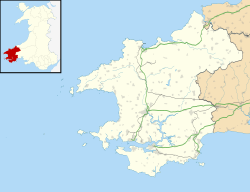Llanstadwell Celtic chariot and fort
In 2018, detectorist Mike Smith found the first remnants of a Celtic chariot burial in some farmland near the village of Waterston in 2018. As of 2024, this is the only chariot burial found in southern Britain. [8] [9] It provides important informations about the poorly known Demetae people, the Iron Age tribe that occupied this region in the pre-Roman and Roman period. [10]
The grave was at the centre of a circular burial monument covered by a soil mound. A first group of artefacts — including fragments of the harness set — was declared a treasure the following year 2019. In March 2019, archaeological surveys and a major excavation of the chariot grave were executed by staff and volunteers led by Dyfed Archaeological Trust, with the participation of National Museum Wales, Cadw (Welsh equivalent of English Heritage), PLANED and Pembrokeshire College. A second collection of chariot fittings and grave goods was recovered, which was declared treasure on June 23, 2022, by HM Coroner for Pembrokeshire, Paul Bennett. The items of that second lot consist of iron tires and associated iron and bronze wheel hub fittings of a two-wheeled chariot, parts of bridle-bits and leather harness fittings, a complete iron sword [10] with a segmented horn handle and that had been encased in a wooden sheath, [11] fragments from two or three spears (suggesting the sepulture of a chief warrior), and some evidence indicating that the body had been laid out on the fighting platform of the chariot — the acidic soil having destroyed the bones of the burial. [10]
The items are dated to the second half of the first century AD, a period when western Britain fought the invading Roman army. [10]
The discovery of this burial mound has led to that of a previously unknown Iron Age promontory fort, also discovered during the archaeological investigations at the site and its surrounding area: [10] the tomb is immediately outside the entrance of the multivallate fort [12] with five lines of ditches and ramparts determined as of 2022. [11] To the west of the chariot burial mound are c. 12 ring-ditches. [12]
See also Wales in the Roman Era.








